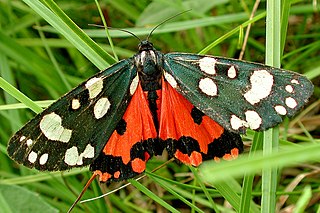
The scarlet tiger moth is a colorful moth belonging to the tiger moth subfamily, Arctiinae. The species was first described by Carl Linnaeus in his 1758 10th edition of Systema Naturae.

The Hepialidae are a family of insects in the lepidopteran order. Moths of this family are often referred to as swift moths or ghost moths.

The common white wave is a moth of the family Geometridae. The species was first described by Carl Linnaeus in his 1758 10th edition of Systema Naturae. It is found throughout the Palearctic region. Their habitat is deciduous forests and their surroundings.
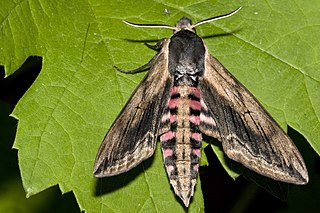
Sphinx ligustri, the privet hawk moth, is a moth found in most of the Palearctic realm. The species was first described by Carl Linnaeus in his 1758 10th edition of Systema Naturae.
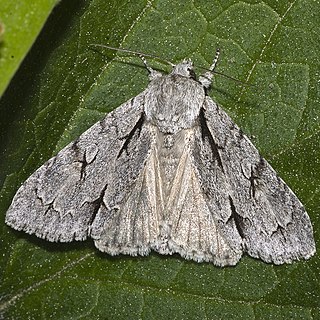
Acronicta is a genus of noctuid moths containing about 150 species distributed mainly in the temperate Holarctic, with some in adjacent subtropical regions. The genus was erected by Carl Linnaeus in his 1758 10th edition of Systema Naturae. Caterpillars of most Acronicta species are unmistakable, with brightly colored hairy spikes, and often feed quite visibly on common foliate trees. The hairy spikes may contain poison, which cause itchy, painful, swollen rash in humans on contact. The larva of the smeared dagger moth is unusually hairy even for this genus. Acronicta species are generally known as dagger moths, as most have one or more black dagger-shaped markings on their forewing uppersides. But some species have a conspicuous dark ring marking instead.
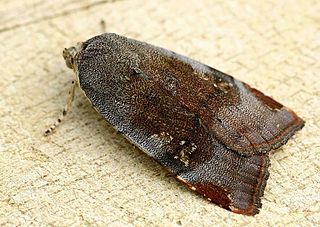
Noctua is a genus of moths. They have dull, cryptic forewings and often very bright hindwings. These are hidden under the forewings when the moths rest, leading to their common name of yellow underwings. They are not particularly closely related to the "true" underwing moths (Catocala) though, apart from both being Noctuoidea. They are good fliers.

Macrothylacia rubi, the fox moth, is a lepidopteran belonging to the family Lasiocampidae. It was first described by Carl Linnaeus in his 1758 10th edition of Systema Naturae.

Hemaris tityus, the narrow-bordered bee hawk-moth, is a moth of the family Sphingidae which is native to the Palearctic.

Abraxas grossulariata is a moth of the family Geometridae, native to the Palearctic realm and North America. Its distinctive speckled coloration has given it a common name of magpie moth. The caterpillar is similarly coloured to the adult, and may be found feeding on the leaves of shrubs such as gooseberry and blackcurrant. The species was first described by Carl Linnaeus in his 1758 10th edition of Systema Naturae.

Anania hortulata, also known as the small magpie, is a species of moth of the family Crambidae found in Asia, Europe and North America. It was described, in 1758, by the 18th-century Swedish taxonomist, botanist, and zoologist, Carl Linnaeus.

Alucita hexadactyla is a "micromoth" of the many-plumed moth family (Alucitidae). It is found in Eurasia. It was previously thought to also occur in North America, but a 2004 study showed that the North American species are distinct and separate.

Arctia villica, the cream-spot tiger, is a moth of the family Erebidae. The species was first described by Carl Linnaeus in his 1758 10th edition of Systema Naturae. It is distributed from the Iberian Peninsula, Anatolia, western and northern Iran, western Siberia, southwestern Asia and North Africa.

Utetheisa pulchella, the crimson-speckled flunkey, crimson-speckled footman, or crimson-speckled moth, is a moth of the family Erebidae. The species was first described by Carl Linnaeus in his 1758 10th edition of Systema Naturae.

Tinea pellionella, the case-bearing clothes moth, is a species of tineoid moth in the family Tineidae, the fungus moths. This species has a cosmopolitan distribution, occurring nearly worldwide.
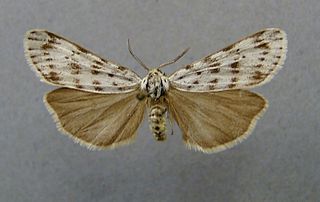
Coscinia cribraria, the speckled footman, is a species of moth belonging to the subfamily Arctiinae within the large family Erebidae. This moth has a widespread distribution in the Palearctic.

Euchloron is a monotypic moth genus of the family Sphingidae first described by Jean Baptiste Boisduval in 1875. Its only species, Euchloron megaera, the verdant hawk, is known from most of Africa and Yemen. It is a migratory species.

Theretra alecto, the Levant hawk moth, is a moth of the family Sphingidae. The species was first described by Carl Linnaeus in his 1758 10th edition of Systema Naturae.
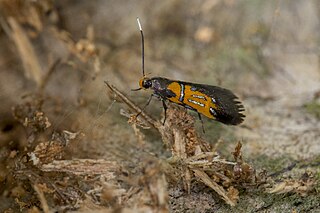
Schiffermuelleria is a genus of concealer moths in the family Oecophoridae. There are more than 30 described species in Schiffermuelleria, found in Europe, Africa, Asia, and New Zealand.
In the 10th edition of Systema Naturae, Carl Linnaeus classified the arthropods, including insects, arachnids and crustaceans, among his class "Insecta". Butterflies and moths were brought together under the name Lepidoptera. Linnaeus divided the group into three genera – Papilio, Sphinx and Phalaena. The first two, together with the seven subdivisions of the third, are now used as the basis for nine superfamily names: Papilionoidea, Sphingoidea, Bombycoidea, Noctuoidea, Geometroidea, Tortricoidea, Pyraloidea, Tineoidea and Alucitoidea.


















